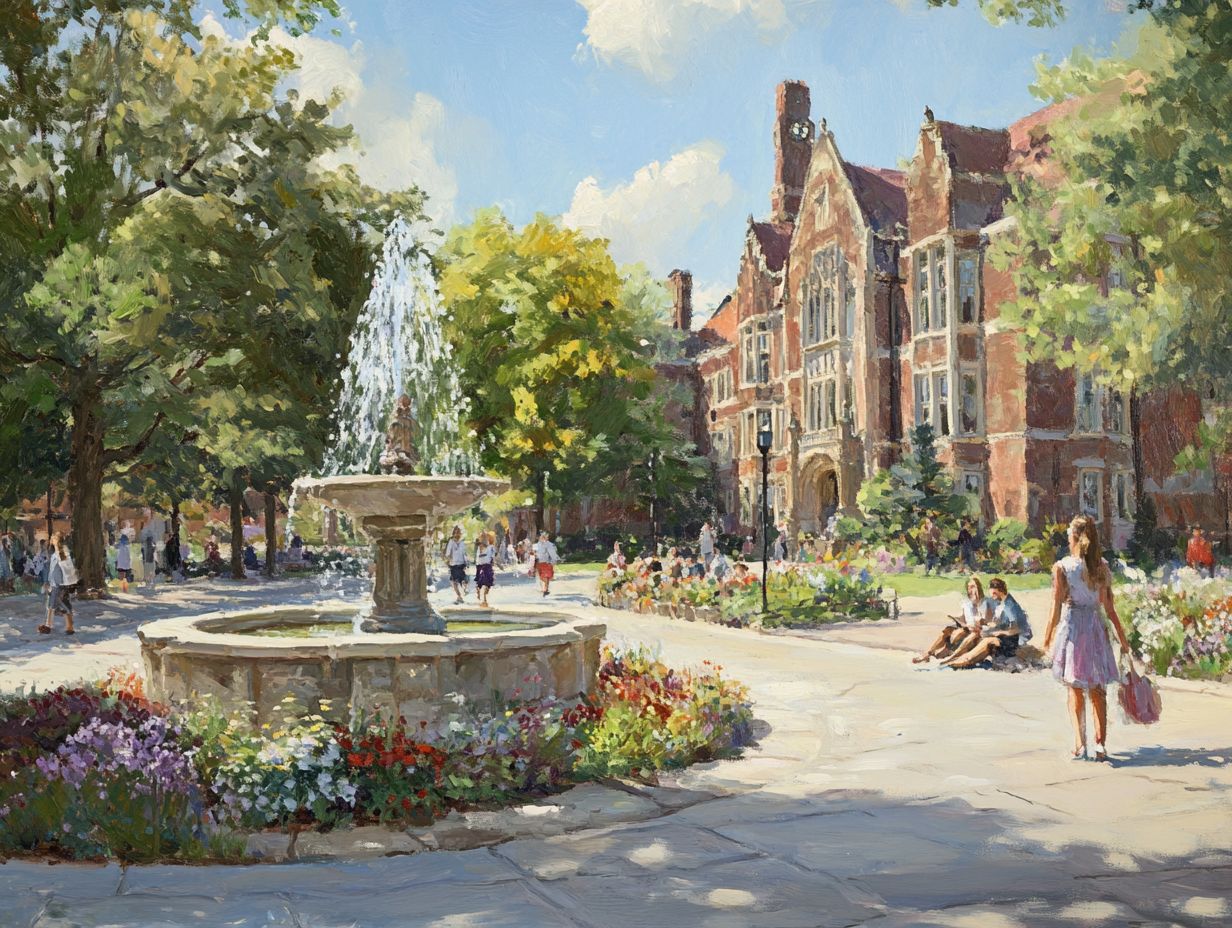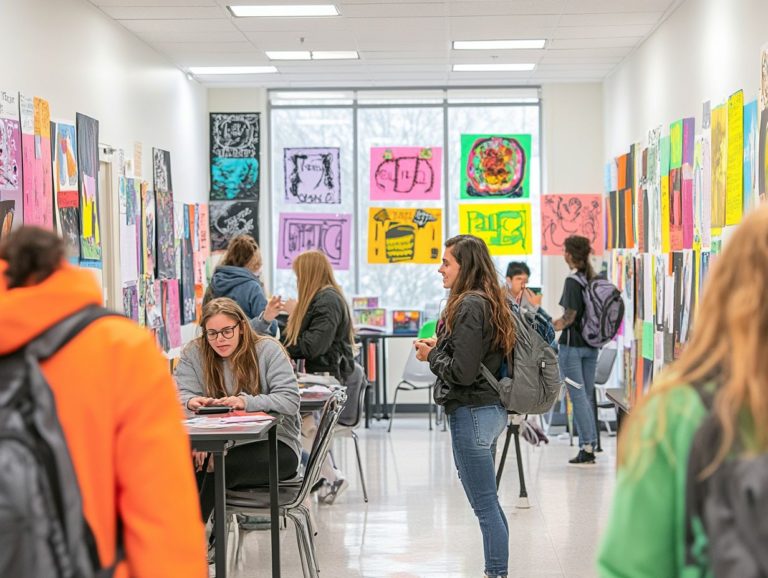10 Must-Visit Cultural Sites Near Your University
Exploring the vibrant cultural landscape surrounding your university can truly elevate your academic journey. From ancient artifacts at the Institute for the Study of Ancient Cultures Museum in Chicago to the historical treasures at the Atlanta History Center, each destination provides a unique window into the diverse heritage of our world.
This guide showcases ten must-visit cultural sites. Discover what you can learn, how these experiences can enrich your education, and tips for planning your adventures. Uncover the treasures that await just beyond your campus!
Contents
- Key Takeaways:
- Institute for the Study of Ancient Cultures Museum
- George W. Bush Presidential Center
- Penn Cultural Heritage Center
- Atlanta History Center
- Kimbell Art Museum
- Cahokia Mounds State Historic Site
- Historical Society of University City
- Department of Art History and Archaeology
- Memorial Art Gallery
- Why Should You Visit These Cultural Sites Near Your University?
- Frequently Asked Questions
- 1. What are the top 10 cultural sites near my university?
- 2. How can I find out more information about these cultural sites?
- 3. Are these cultural sites free to visit?
- 4. Can I bring a group to visit these cultural sites?
- 5. How far are these cultural sites from my university?
- 6. Are these cultural sites only for students or can anyone visit?
Key Takeaways:

- Explore ancient cultures at the Institute for the Study of Ancient Cultures Museum in Chicago, IL.
- Gain insight into US history at the George W. Bush Presidential Center in Dallas, TX.
- Immerse yourself in diverse cultural heritage at the Penn Cultural Heritage Center near your university.
Institute for the Study of Ancient Cultures Museum
The Institute for the Study of Ancient Cultures Museum, nestled in the vibrant heart of Philadelphia, is a crucial collection of artifacts and displays celebrating the intricate tapestry of ancient civilizations.
Here, you can immerse yourself in cultural histories that have profoundly influenced modern society, particularly within the framework of American democracy. Historic attractions like the Liberty Bell and Independence Mall are also nearby.
As you wander through the museum, discover diverse exhibits showcasing relics from ancient Mesopotamia to the Mayan civilization, each whispering tales of human endurance and innovation.
Among its prized possessions are meticulously preserved pottery, intricate textiles, and historical manuscripts that resonate with the philosophical ideals of America s founding fathers.
Exploring these artifacts provides valuable insights into how ancient cultures established foundational principles of governance and civic responsibility, which means being active and engaged in your community.
The museum enhances your understanding of nearby landmarks and enriches your educational experience by providing context that illuminates the continuity of democratic ideals throughout history. This connection shows just how important it is to understand our past in shaping a more informed and enlightened future!
George W. Bush Presidential Center
The George W. Bush Presidential Center is a remarkable landmark that seamlessly blends education and engagement with American democracy.
It showcases pivotal events and policies from the Bush administration while connecting to Philadelphia s rich historical sites, such as Independence Hall and the National Constitution Center.
As you explore the center, you’ll encounter a variety of unique exhibits, including interactive displays that encourage deeper reflection on critical issues, emphasizing the vital importance of civic participation.
The center also offers educational programs designed to foster discussions about the foundations of democracy, making it an invaluable resource for both students and educators.
Its close proximity to other significant landmarks enhances its importance, weaving a rich tapestry of American history that highlights the legacy of presidential leadership and the democratic ideals that have shaped the nation.
This integration with Philadelphia’s historic attractions reinforces the center’s role in the ongoing narrative of liberty and governance in the United States. Don t miss out on these incredible opportunities to explore the past!
Penn Cultural Heritage Center
The Penn Cultural Heritage Center serves as a vital hub of education and outreach in Philadelphia, committed to the preservation and promotion of the city s rich cultural heritage. This heritage is intricately linked to significant historic attractions like the Betsy Ross House and the African American Museum.
Through an array of dynamic programs and captivating exhibitions, the center beautifully illustrates the diverse tapestry of traditions and narratives that shape the community. One of its standout initiatives features workshops that celebrate local customs, allowing you to delve into everything from traditional crafts to contemporary artistic expressions.
The center collaborates with prestigious institutions such as the Philadelphia Museum of Art and local universities. By connecting the stories of Philadelphia s historic landmarks into its programming, the center brings Philadelphia s past to life, creating exciting connections to the present. This sparks a vibrant dialogue that resonates with both residents and visitors.
Atlanta History Center
The Atlanta History Center is an expansive complex that doesn t just narrate Atlanta’s story; it weaves connections to broader themes in American history. You ll find ties to Philadelphia’s historic attractions, like the Museum of the American Revolution and Christ Church, illuminating the common threads that unite these significant cultural sites.
As you explore its diverse exhibits featuring engaging displays on the Civil War and Southern culture you’ll gain valuable insights into pivotal moments that shaped not only Georgia but the nation as a whole. Special programs, including lectures and interactive workshops, often draw parallels between regional histories, enriching your understanding of the American experience.
The center partners with traveling exhibits and organizations, much like those in Philadelphia, allowing the Atlanta History Center to enhance its offerings. This creates a dialogue between the rich legacies of both cities and underscores the timeless relevance of historical narratives. It invites you to reflect on the shared past that connects us all.
Kimbell Art Museum

The Kimbell Art Museum in Texas boasts a distinguished collection of art that resonates with cultural significance akin to historic attractions like the Weitzman National Museum. Dive into exhibits that showcase the fascinating journey of art and culture woven into the American narrative.
The museum itself is a beautifully designed building, created by the visionary Louis Kahn. His masterful emphasis on natural light elevates your viewing experience of remarkable works, including masterpieces by luminaries such as Caravaggio and Monet.
This incredible museum is vital to America s cultural landscape, paralleling Philadelphia s vibrant art scene, which overflows with history and creativity. The connection between these two cultural hubs underscores how diverse artistic expressions enrich a broader understanding of America’s cultural evolution. It encourages you to appreciate both the past and the contemporary art that actively shapes today s American identity.
Don’t miss out plan your visit to explore these cultural treasures today!
Cahokia Mounds State Historic Site
Cahokia Mounds State Historic Site in Illinois offers you a fascinating contrast into the lives of ancient cultures. This site provides a compelling look alongside Philadelphia’s historic attractions like Franklin Square and Elfreth s Alley. Together, these locations reflect a legacy that has significantly influenced American identity.
The earthen mounds, remnants of a once-thriving urban center inhabited by the Native Americans living in the Mississippi River Valley, unveil intricate social structures, trade networks, and spiritual practices that predate European influence. As you explore, you’ll encounter excavated artifacts ranging from pottery to tools each piece offering invaluable insight into the region’s pre-Columbian history.
Philadelphia’s historic sites also capture the evolution of democratic values and the revolutionary spirit that shaped the nation. They artfully bridge indigenous heritage with colonial development. Both locations stand as powerful reminders of America’s diverse historical tapestry, each contributing unique narratives that deepen your understanding of the cultural forces that have shaped the country.
Historical Society of University City
The Historical Society of University City is a crucial institution that preserves the history and cultural narratives of Philadelphia s University City area. Here, you can gain insights into local historic attractions that resonate with broader themes found at iconic sites like the Mother Bethel AME Church and Carpenters Hall.
Through a variety of educational programs and engaging exhibits, the society encourages a deeper understanding of pivotal moments in American democracy and the influential individuals who shaped them. For instance, exhibitions that spotlight figures such as Paul Robeson and key events like the civil rights movement reveal the connections between local history and national struggles.
These initiatives are designed not only to educate residents and visitors but also to cultivate a sense of community pride and shared memory. They link the past to the ongoing narratives that define Philadelphia’s vibrant culture, inviting you to become a part of this living history.
Department of Art History and Archaeology
Come and discover the treasures of art and culture at the Department of Art History and Archaeology. This department invites you to delve deeply into the academic exploration of cultural artifacts and artistic expression, forging connections between global histories and the historical treasures of Philadelphia, such as the Museum of the American Revolution and Franklin Square.
The curriculum immerses you in both theoretical frameworks and practical applications, encouraging profound engagement with historical contexts. You ll have access to robust research opportunities, collaborating on projects that examine a variety of artistic movements and archaeological discoveries.
Importantly, partnerships with local museums and cultural institutions enhance your learning experience. Joint exhibitions and community outreach programs provide you with a hands-on understanding of Philadelphia’s rich artistic tapestry. These initiatives not only support the educational mission but also cultivate a deeper appreciation for the dynamic interplay between art, history, and the vibrant cultural landscape of the city.
Memorial Art Gallery
Explore the Memorial Art Gallery, where art comes alive and cultural stories unfold. This dynamic institution invites you to discover a captivating array of art that echoes the themes found in Philadelphia’s historic gems like the Powel House and the Museum of the American Revolution.
It is not merely a gallery; it hosts an engaging lineup of temporary exhibits showcasing the talents of both contemporary and historical artists, alongside permanent collections that traverse diverse cultures and time periods.
Don t miss out on the chance to witness this vibrant institution actively engaging with the community. It offers educational programs designed to deepen your understanding of art and its pivotal role in society. By fostering cultural awareness and appreciation, the gallery connects you to Philadelphia s rich artistic traditions through workshops, lectures, and collaborative events that celebrate creativity in all its forms.
Why Should You Visit These Cultural Sites Near Your University?
Visiting cultural sites near your university, like the historic attractions in Philadelphia think Liberty Bell, Independence Mall, and the African American Museum adds a whole new layer to your educational journey. It s about creating a tangible connection to history and deepening your understanding of American democracy and its diverse cultural narratives.
These experiences immerse you in the artifacts and stories that shaped the nation. You will grasp complex concepts in ways that textbooks simply can t deliver. The vibrant atmosphere of these sites sparks exploration and critical thinking, fostering personal growth and a sense of civic responsibility.
In Philadelphia, where revolutionary ideals meet a rich tapestry of cultural influences, you will discover an exciting learning environment that encourages reflection on the past while considering your role in shaping the future. This blend of history and culture cultivates well-rounded individuals, like you, who are prepared to make meaningful contributions to society.
What Can You Learn from These Cultural Sites?
Cultural sites in Philadelphia, such as the Museum of the American Revolution and the National Constitution Center, offer invaluable lessons about history, art, and the evolution of American democracy. These destinations are must-visits for both students and history enthusiasts alike.
By immersing yourself in the rich tapestry of narratives presented at these locations, you can gain a deeper understanding of the historical context surrounding pivotal moments in America s journey. Take, for example, the Liberty Bell a powerful symbol of freedom that serves as a poignant reminder of the struggles faced in the quest for independence. Then there’s Christ Church, renowned for its role in the Revolution, showcasing how religious institutions shaped societal values.
Through artful exhibits and interactive displays, you don t just learn about the past; you also come to appreciate the cultural significance these landmarks hold. They reinforce the idea that art can shape narratives that inspire future generations.
How Can Visiting These Sites Enhance Your University Experience?
Visiting Philadelphia’s cultural sites elevates your university experience by offering hands-on learning experiences that enhance critical thinking and forge connections between classroom knowledge and real-world applications, especially regarding American democracy and its rich historical narratives.
When you take the time to explore iconic locations like the Liberty Bell or Independence Hall, you encounter the very foundations of the nation’s values and principles. This engagement not only deepens your understanding of historical events but also encourages you to analyze their broader implications on contemporary society.
For instance, if you re studying political science, walking through the very streets where the nation’s founding debates took place makes your coursework feel more relatable and impactful. This experience transforms abstract concepts into tangible realities and inspires a deeper commitment to your studies and personal growth.
What Are the Unique Features of Each Cultural Site?
Each cultural site in Philadelphia, from the historic Powel House to the contemporary exhibits at the National Constitution Center, offers unique features that enrich your understanding of American history and cultural heritage.
The Powel House, with its stunning Georgian architecture a style popular in the 18th century invites you to step back in time and experience the lives of the city s colonial elite. Here, you ll find meticulously preserved furnishings and captivating stories of political intrigue from the American Revolution.
On the other hand, the National Constitution Center shines as a symbol of democratic ideals. It presents interactive displays and immersive experiences that draw you into the foundational principles of the United States.
These contrasting architectural styles and exhibit approaches not only capture the diverse narratives that have shaped the nation but also promise an enriching educational journey for anyone who explores these iconic sites.
Start planning your visit today to connect with history like never before!
How Can You Plan a Visit to These Cultural Sites?
When you plan your visit to Philadelphia’s cultural treasures, like the Museum of the American Revolution and Franklin Square, it’s essential to do a bit of research. Checking opening hours, special events, and educational programs can significantly enhance your experience.
To truly make the most of your trip, take a moment to check the museums’ websites for any holiday hours or unexpected closures. Purchasing your tickets online not only saves you precious time but can often lead to discounts, especially if you’re traveling with family or looking for educational passes.
Utilizing resources such as virtual tours or printable guides can enrich your in-person experience, providing context and depth. Don t miss out on unique programs like themed guided tours or scavenger hunts that pop up during major events; these exciting offerings can elevate your learning!
What Are the Benefits of Exploring Your University’s Surrounding Cultural Sites?

Exploring the cultural sites surrounding your university, especially those in Philadelphia like the historic Elfreth s Alley and the National Constitution Center, offers many benefits. You ll enhance your cultural awareness, diversify your learning opportunities, and cultivate a deeper appreciation for American democracy.
Engaging with cultural sites offers rich narratives from various eras, allowing you to connect with the struggles and triumphs that have shaped our society. Visiting museums and landmarks not only complements your academic studies but also fosters valuable social interactions with peers and community members, creating a genuine sense of belonging.
For instance, participating in local heritage festivals can spark conversations about cultural identity and history, deepening your understanding of your own background and those of others. Such interactions play a significant role in your personal growth, encouraging empathy and critical thinking skills that are invaluable in today s interconnected world.
Frequently Asked Questions
1. What are the top 10 cultural sites near my university?
There are many cultural sites near your university, but some of the top must-visit options include the Institute for the Study of Ancient Cultures Museum, George W. Bush Presidential Center, Penn Cultural Heritage Center, Atlanta History Center, Kimbell Art Museum, Cahokia Mounds State Historic Site, Historical Society of University City, Department of Art History and Archaeology, and 5 must-see cultural landmarks in your host city.
2. How can I find out more information about these cultural sites?
You can find out more information about these cultural sites by contacting the respective institutions. However, some may not have a contact listed, so you may need to do some additional research online.
3. Are these cultural sites free to visit?
Some of these cultural sites may have an admission fee, while others may be free to visit. It is best to check with each individual site to find out their specific policies.
4. Can I bring a group to visit these cultural sites?
Yes, many of these cultural sites allow groups to visit. However, it is best to contact the site beforehand to make arrangements and ensure there are no restrictions.
5. How far are these cultural sites from my university?
The distance to these cultural sites may vary depending on the location of your university. We recommend using a map service, such as Google Maps, to calculate the distance and determine the best mode of transportation.
6. Are these cultural sites only for students or can anyone visit?
These cultural sites are open to the general public, not just students. They are great places for anyone to learn about and experience different cultures and historical artifacts.







